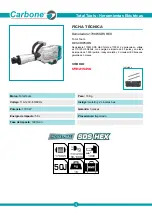
Safety Information
ETP SRB81-300-20-D
6
© Atlas Copco Industrial Technique AB - 9834 6192 00
Signature of issuer
Authorised Representative UK:
Atlas Copco Ltd
Swallowdale Lane
Hemel Hempstead
Hertfordshire HP2 7EA
Safety
DO NOT DISCARD - GIVE TO USER
WARNING Read all safety warnings, instructions, il-
lustrations and specifications provided with this
product.
Failure to follow all instructions listed below may result
in electric shock, fire, property damage and/or serious
injury.
Save all warnings and instructions for future refer-
ence.
WARNING All locally legislated safety rules regard-
ing installation, operation and maintenance shall be
respected at all times.
Statement of Use
• For professional use only.
• This product and its accessories must not be modified in
any way.
• Do not use this product if it has been damaged.
• If the product data or hazard warning signs on the prod-
uct cease to be legible or become detached, replace with-
out delay.
• The product must only be installed, operated and ser-
viced by qualified personnel in an industrial environ-
ment.
Intended Use
This product is designed for installing and removing threaded
fasteners in wood, metal or plastic. Indoor use only.
No other use permitted.
Product Specific Instructions
General Installation Safety
Refer installation to qualified personnel only.
Hang the tool securely, by for example using a balancer.
When using a suspension yoke, check that it is in good con-
dition and correctly fastened.
General Operation Safety
•
Due to entanglement risk, do not wear gloves.
•
Be prepared of the reaction force which will occur
when the tool is used.
Always support the tool’s handle
securely in the direction opposite to the spindle rotation,
in order to reduce the effect of sudden torque reaction
during final tightening and initial loosening.
•
Never hold the drive, socket or drive extension.
•
Operators and maintenance personnel must be physi-
cally able to handle the bulk, weight and power of the
tool.
•
If possible, use a suspension arm to absorb the reac-
tion torque. If that is not possible, side handles are
recommended for straight-case and pistol-grip tools;
reaction bars are recommended for angle nutrun-
ners.
It is recommended to use a means to absorb the re-
action torque above 4 Nm (3 lbf.ft) for straight-case
tools, above 10 Nm (7.5 lbf.ft) for pistol-grip tools, and
above 60 Nm (44 lbf.ft) for angle nutrunners.
•
Serious injury can result from over-torqued or un-
der-torqued fasteners.
Assemblies requiring a specific
torque must be checked using a torque meter. So-called
“click” torque wrenches do not check for potentially
dangerous over-torqued conditions. Over-torqued or un-
der-torqued fasteners can break, loosen or separate. Re-
leased assemblies can become projectiles.
•
Use only power or impact sockets in good condition.
Do not use hand sockets.
•
When using a power tool, the operator may feel dis-
comfort in the hands, arms, shoulders, neck, or other
parts of the body.
Vary between appropriate postures
throughout the work day, maintain a secure footing and
avoid awkward or off-balance postures.
•
Repetitive work motions, awkward positions and ex-
posure to vibration can be harmful to hands and
arms.
If numbness, tingling, pain or whitening of the
skin occurs, stop using tool and consult a physician.
•
Take caution when operating in confined spaces.
Be-
ware of crushing hands between tool and workpiece.
•
High sound levels can cause permanent hearing
loss.
Use hearing protection as recommended by your
employer or occupational health and safety regulations.
•
Ensure that the workpiece is securely fixed
.
•
Proceed with care in unfamiliar surroundings.
Be
aware of potential hazards created by your work activity.
This tool is not insulated from coming into contact with
electric power sources.
Tools used together with a reaction bar:
Never put your
hand near or close to the reaction bar while the tool is being
used. Be aware of the rotational direction of the spindle be-
fore starting the tool, the reaction force may work in an unex-
pected direction with risk of crushing injuries.
Tools containing a clutch:
Never use the product without
making sure the clutch releases. Immediately after adjusting
the clutch, check for correct operation.







































